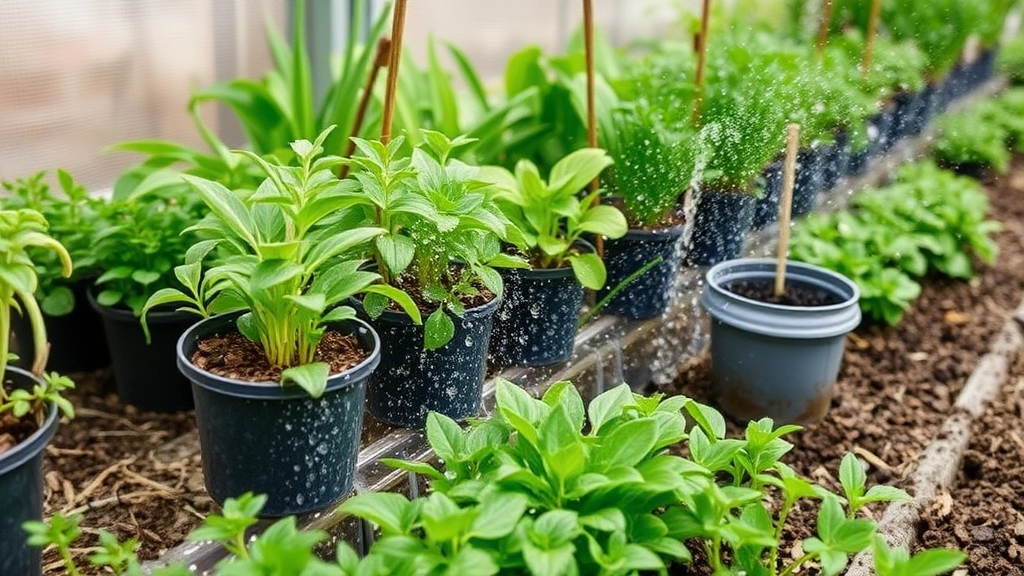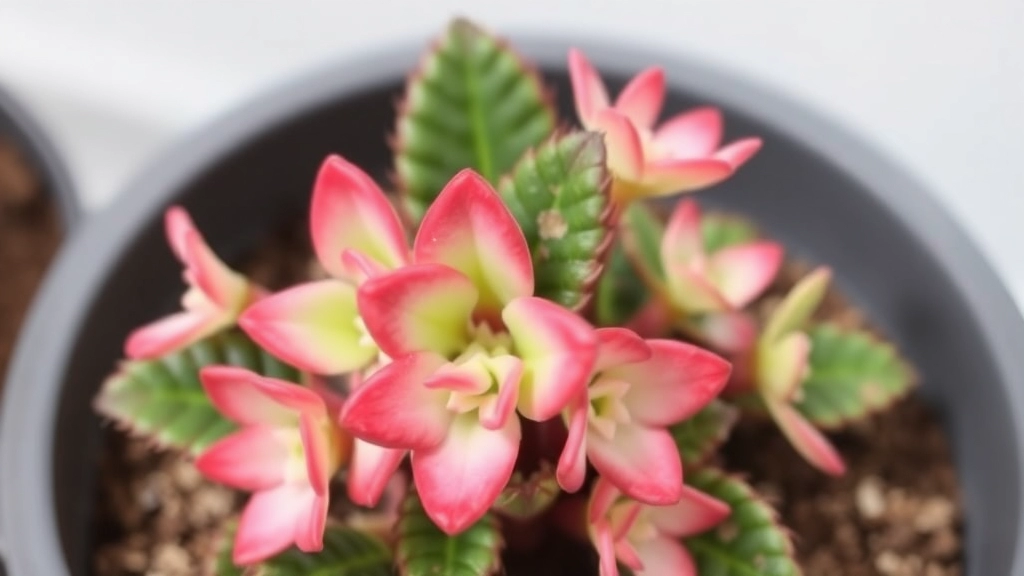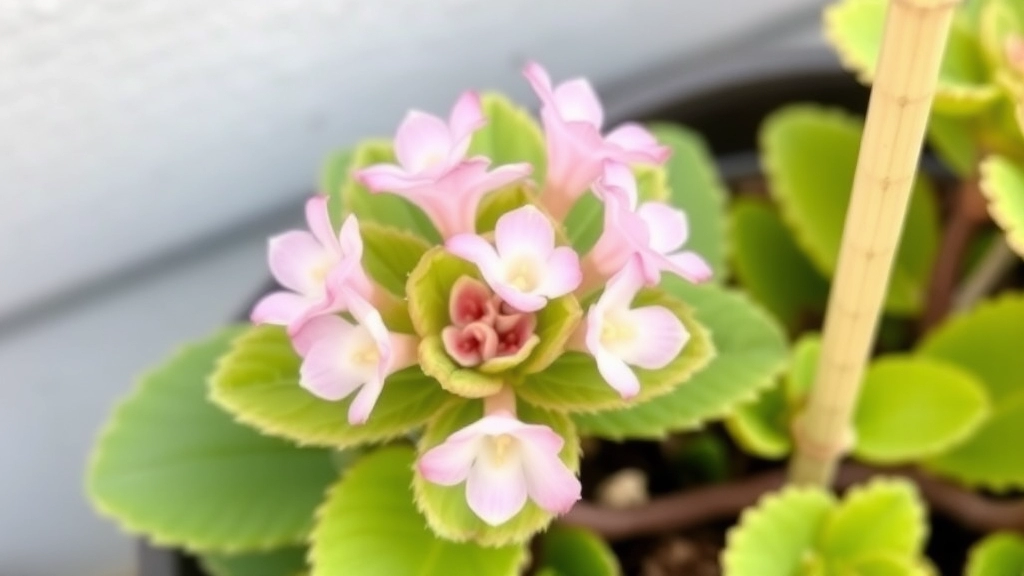Kalanchoe Beharensis Care Guide
If you’re looking to master Kalanchoe Beharensis care, you’ve come to the right place. This unique succulent, often called the Velvet Leaf or Elephant Ear, thrives with the right attention. Let’s dive into the essentials, from lighting and watering to soil and propagation, ensuring your plant flourishes indoors or outdoors.
Lighting
First, let’s talk about lighting. Kalanchoe Beharensis loves bright, indirect sunlight. Place it near a window where it can soak up the rays without getting scorched.
Watering
Next, watering is crucial—this plant prefers its soil to dry out between waterings. Overwatering can lead to root rot, so be cautious.
Soil
For soil, a well-draining mix is key. Think cactus or succulent soil blends that prevent water from sitting around the roots. Stay tuned as we explore more tips and tricks for keeping your Kalanchoe Beharensis in top shape.
Optimal Lighting Conditions for Kalanchoe Beharensis
When it comes to growing Kalanchoe Beharensis, one of the most pressing questions is about its lighting needs.
Why is Lighting So Crucial?
Kalanchoe Beharensis thrives in bright, indirect light. A well-lit environment encourages healthy growth and vibrant foliage. Here’s what you need to consider:
- Direct Sunlight:
- While Kalanchoe can tolerate some direct sunlight, prolonged exposure can scorch its leaves.
- Morning sun is ideal; it’s gentler and helps the plant absorb light without the risk of burning.
- Filtered Light:
- If you can’t provide direct sunlight, consider placing your plant near a window with sheer curtains.
- This allows the plant to receive ample light while protecting it from harsh rays.
- Artificial Lighting:
- If natural light is limited, you can use grow lights.
- Aim for 12-14 hours of light per day to mimic its natural habitat.
Signs of Improper Lighting:
Keep an eye out for these indicators:
- Leggy Growth:
- If your Kalanchoe is stretching towards the light, it’s likely not getting enough.
- Faded Colour:
- Leaves losing their vibrant green hue may indicate too much direct sunlight.
For more detailed care tips, check out our care and propagation guide for Kalanchoe Beharensis. Additionally, if you’re interested in other varieties, don’t miss our guide on different types of Kalanchoe Tomentosa.
Watering Schedule and Techniques

So, you’ve got your Kalanchoe Beharensis all set up and looking fab, but now you’re probably wondering about watering.
How much water does it actually need?
Kalanchoe Beharensis, like many succulents, thrives on a careful watering routine. Too much water, and you risk root rot; too little, and it’ll start to shrivel. It’s all about finding that sweet spot.
Watering Schedule
- Check the Soil: Before you even think about watering, stick your finger about an inch into the soil. If it feels dry, it’s time to water.
- Frequency: Generally, every 2-3 weeks in the growing season (spring and summer) is a good rule of thumb. In the winter, you can stretch that to once a month.
- Signs of Thirst: Look out for droopy leaves or a wrinkled appearance—those are your plant’s way of saying, “Hey, a drink would be nice!”
Watering Techniques
- Method: When watering, do it thoroughly. Pour water until it drains out of the bottom of the pot. This ensures the roots are getting enough moisture.
- Avoiding Overhead Watering: Try to water at the base of the plant. This helps prevent fungal issues and keeps the leaves dry.
- Use Room Temperature Water: Cold water can shock the roots. A little warmth goes a long way in keeping your plant happy.
Additional Tips
- Seasonal Adjustments: In hotter months, your plant might need a bit more water. Keep an eye on it and adjust as needed.
- Drainage is Key: Always use pots with drainage holes. Standing water is a big no-no for Kalanchoe Beharensis.
Best Soil Types and Potting Requirements
When it comes to ensuring your Kalanchoe Beharensis thrives, the right soil and potting conditions are essential. Many plant enthusiasts worry about selecting the perfect soil mix, and it’s a valid concern.
Ideal Soil Composition
Kalanchoe Beharensis prefers well-draining soil to prevent root rot. Here’s what you should consider:
- Cactus or Succulent Mix: These mixes are specifically formulated to provide excellent drainage, which is crucial for Kalanchoe.
- Perlite or Pumice: Adding these materials enhances aeration and drainage. Aim for a mix that’s about 50% cactus mix and 50% perlite.
- Organic Matter: Incorporating a small amount of organic matter can provide essential nutrients without compromising drainage.
Potting Requirements
Choosing the right pot is just as important as selecting the soil. Here are some key points to keep in mind:
- Drainage Holes: Always use pots with drainage holes to allow excess water to escape.
- Size Matters: Choose a pot that is slightly larger than the root ball. This gives the plant room to grow without holding too much moisture.
- Material: Terracotta pots are ideal as they are porous and help regulate moisture levels.
Repotting Considerations
As your Kalanchoe grows, it may need repotting. Here’s when and how to do it:
Temperature and Humidity Preferences

When caring for Kalanchoe Beharensis, understanding its temperature and humidity preferences is crucial.
Are you worried about your plant thriving in varying climates?
Kalanchoe Beharensis, often known as the “Chandelier Plant,” prefers a warm environment.
Ideal Temperature Range:
- Daytime: 20°C to 25°C (68°F to 77°F)
- Nighttime: 15°C to 18°C (59°F to 65°F)
Temperatures below 10°C (50°F) can stress your plant, leading to poor growth or even death.
Humidity Needs:
- Kalanchoe Beharensis thrives in low to moderate humidity.
- Aim for humidity levels around 30% to 50%.
If your home is particularly humid, ensure good air circulation to prevent mold and rot.
Tips for Maintaining Optimal Conditions:
- Indoor Placement: Keep your plant away from drafty windows and heating vents.
- Outdoor Care: If placed outside, ensure it’s in a sheltered spot, especially during cooler months.
- Humidity Control: Use a dehumidifier if necessary, or place a small fan near the plant.
Fertilizing Tips for Healthy Growth
When caring for your Kalanchoe Beharensis, proper fertilization is key to ensuring vibrant growth and longevity. You might be wondering, “How often should I fertilize my plant?” or “What type of fertiliser is best?” Let’s dive into some straightforward tips to keep your plant thriving.
Choosing the Right Fertiliser
- Type: Opt for a balanced, water-soluble fertiliser, ideally with an N-P-K ratio of 10-10-10 or 20-20-20. This ensures your plant receives essential nutrients.
- Organic Options: If you prefer organic, consider fish emulsion or seaweed extract. These provide slow-release nutrients and improve soil health.
Fertilization Schedule
- Growing Season: During the active growing season (spring and summer), fertilise every 4-6 weeks.
- Dormancy: In autumn and winter, reduce fertilisation to once every 8-10 weeks, as the plant’s growth slows.
Application Techniques
- Dilution: Always dilute the fertiliser to half the recommended strength. This prevents root burn and nutrient overload.
- Watering: Apply the fertiliser after watering your plant. This helps distribute the nutrients evenly and reduces the risk of burning the roots.
Signs of Nutrient Deficiency
Keep an eye out for these signs that may indicate your Kalanchoe Beharensis needs more nutrients:
- Yellowing Leaves: Often a sign of nitrogen deficiency.
- Stunted Growth: Indicates a lack of essential nutrients.
- Poor Flowering: If your plant isn’t blooming, it might need more phosphorus.
For more detailed care tips, you can check out this care and propagation guide for Kalanchoe Beharensis. Additionally, if you’re interested in other Kalanchoe varieties, the guide for growing and caring for Kalanchoe Tomentosa might be of interest.
Common Pests and Diseases to Watch Out For

So, you’ve got your Kalanchoe Beharensis thriving, but what happens when those pesky pests or sneaky diseases decide to crash the party?
Let’s dive into some common issues you might face and how to tackle them.
Pests to Keep an Eye On
- Mealybugs
- These little white fluff balls love to hide in leaf crevices.
- They suck the sap from your plant, causing leaves to yellow and drop.
- Tip: Wipe them off with a cotton swab dipped in alcohol.
- Aphids
- Tiny green or black bugs that cluster on new growth.
- They can stunt your plant’s growth and spread diseases.
- Tip: Spray them off with water or use insecticidal soap.
- Spider Mites
- You might notice tiny webs on your plant.
- They thrive in dry conditions and can cause leaf discoloration.
- Tip: Increase humidity around your plant and spray with neem oil.
Diseases to Be Aware Of
- Root Rot
- Often caused by overwatering, this can be a real killer.
- Look out for mushy roots and yellowing leaves.
- Tip: Ensure your pot has good drainage and let the soil dry out between waterings.
- Powdery Mildew
- This looks like a white powder on leaves and can spread quickly.
- It thrives in high humidity and low airflow.
- Tip: Improve airflow around your plant and avoid overhead watering.
- Leaf Spot
- Dark spots on leaves can signal fungal infections.
- This can happen if water sits on the leaves.
- Tip: Water at the base and remove affected leaves promptly.
Pruning and Grooming Techniques
As we delve into the care of Kalanchoe Beharensis, it’s essential to consider how pruning and grooming can enhance its health and appearance.
Why Prune?
Pruning serves multiple purposes, including:
Repotting Guidelines for Mature Kalanchoe Beharensis

When it comes to keeping your Kalanchoe Beharensis thriving, repotting is a key step that often raises questions.
Why Repot?
You might be wondering, “When should I repot my plant?” or “How do I know if it needs a new pot?”
Here’s the thing:
- Roots Outgrowing the Pot: If you see roots poking out of the drainage holes, it’s time.
- Soil Degradation: If the soil is compacted or looks tired, that’s another sign.
- Growth Stagnation: If your plant isn’t growing as it should, it might be root-bound.
When to Repot
The best time to repot your Kalanchoe Beharensis is during the spring or early summer when it’s actively growing. This gives it the best chance to adapt to its new home.
How to Repot
Here’s a simple step-by-step guide to make repotting a breeze:
- Choose the Right Pot: Pick a pot that’s 1-2 inches larger in diameter than the current one. Ensure it has drainage holes.
- Prepare the Soil: Use a well-draining cactus or succulent mix. You can also mix regular potting soil with sand or perlite to improve drainage.
- Remove the Plant: Gently take the plant out of its old pot. You might need to tap the sides or use a knife to loosen the soil.
- Inspect the Roots: Check for any rotten or dead roots and trim them away. Healthy roots should be firm and white.
- Position the Plant: Place your Kalanchoe Beharensis in the new pot, ensuring it sits at the same depth as before. Fill in with fresh soil, leaving some space at the top for watering.
- Water Lightly: After repotting, give it a light watering to help settle the soil, but avoid soaking it right away.
- Give It Time: Allow your plant to adjust in a shaded area for a week or so before returning it to its usual spot.
By following these repotting guidelines, you’ll set your Kalanchoe Beharensis up for a strong growth phase.
Propagation Methods: Seeds, Cuttings, and Offsets
As we delve into the propagation of Kalanchoe Beharensis, it’s crucial to understand the various methods available. Each method has its own benefits and can be tailored to suit your gardening style.
1. Propagating from Seeds
Starting from seeds can be a rewarding yet patient process.
- Gathering Seeds: Collect seeds from mature flowers when they dry out.
- Sowing:
- Use a seed tray filled with well-draining soil.
- Lightly press the seeds into the soil, ensuring they are not buried too deep.
- Watering: Mist the soil gently to avoid displacing the seeds.
- Light Conditions: Place the tray in bright, indirect sunlight.
2. Propagating from Cuttings
This method is often preferred for its speed and simplicity.
- Choosing Cuttings: Select healthy stems with at least two leaves.
- Cutting Technique:
- Use a clean, sharp knife to take a cutting about 10-15 cm long.
- Allow the cut end to dry for a few hours to form a callus.
- Planting:
- Insert the cutting into a pot filled with well-draining soil.
- Water sparingly until roots develop.
- Rooting Time: Expect roots to form within a few weeks.
3. Propagating from Offsets
Offsets are small plantlets that grow around the base of the main plant.
Seasonal Care: Adapting to Growth and Dormancy Cycles for Kalanchoe Beharensis

Have you ever wondered how to keep your Kalanchoe Beharensis thriving through the changing seasons?
Understanding its growth and dormancy cycles is key to giving it the best care possible.
Growth Phase: Spring and Summer
During spring and summer, your Kalanchoe is in full swing, soaking up the sun and growing like crazy.
Here’s how to help it flourish:
- Increase Watering: As the temperatures rise, your plant will need more hydration. Water it when the top inch of soil feels dry.
- Fertilize: Use a balanced, water-soluble fertilizer every 4-6 weeks to support its growth.
- Optimal Light: Ensure it gets plenty of bright, indirect sunlight. Too much direct sun can scorch the leaves.
I remember when I first noticed my Kalanchoe growing taller and bushier. It was such a thrill!
Dormancy Phase: Autumn and Winter
As autumn rolls in, your Kalanchoe will start to slow down.
Here’s what to do during its dormancy:
- Reduce Watering: Cut back on watering. Water only when the soil is completely dry to avoid root rot.
- Lower Fertilizer: Stop fertilizing during this period to let it rest.
- Cooler Temperatures: Keep it in a cooler spot, ideally between 10-15°C (50-59°F).
I’ve found that giving it a break during winter helps it bounce back beautifully in spring.
Adapting to Changes
Every plant is unique, and your Kalanchoe may have its quirks.
Pay attention to its leaves and overall health.
- Yellowing Leaves: Could mean overwatering in winter.
- Stunted Growth: Might indicate insufficient light or nutrients in summer.
By adapting your care routine to these seasonal changes, you’ll keep your Kalanchoe Beharensis healthy and happy all year long.
Troubleshooting Common Care Issues
As we delve into the common care issues that Kalanchoe Beharensis enthusiasts often face, it’s essential to consider how to maintain the plant’s health and vibrancy.
Common Problems and Solutions
1. Yellowing Leaves
Causes:
- Overwatering
- Poor drainage
Solutions:
- Allow the soil to dry out between waterings.
- Ensure your pot has adequate drainage holes.
2. Wilting or Drooping Leaves
Causes:
- Underwatering
- Excessive heat
Solutions:
- Check the soil moisture; if dry, give it a thorough watering.
- Move the plant to a cooler location if temperatures are too high.
3. Leaf Drop
Causes:
- Sudden temperature changes
- Stress from repotting
Solutions:
- Keep the plant in a stable environment.
- Avoid repotting during extreme temperature fluctuations.
4. Pests
Common Pests:
- Mealybugs
- Spider mites
Solutions:
- Inspect leaves regularly.
- Treat infestations with insecticidal soap or neem oil.
5. Stunted Growth
Causes:
- Nutrient deficiency
- Poor soil quality
Solutions:
- Fertilise with a balanced fertilizer during the growing season.
- Use high-quality potting mix designed for succulents.
For more detailed care tips, you might want to check out our care tips for Kalanchoe Beharensis Cv. Fang and the Elephant Ear Kalanchoe Beharensis care and propagation guide.
FAQs on Kalanchoe Beharensis Care
How often should I water my Kalanchoe Beharensis?
Generally, you should water your Kalanchoe Beharensis every 2-3 weeks during the growing season (spring and summer). In the winter, you can extend this to once a month. Always check the soil first; if it feels dry an inch deep, it’s time to water.
What is the ideal temperature range for Kalanchoe Beharensis?
Kalanchoe Beharensis thrives in daytime temperatures between 20°C to 25°C (68°F to 77°F) and nighttime temperatures between 15°C to 18°C (59°F to 65°F). Temperatures below 10°C (50°F) can stress the plant.
What kind of humidity levels does Kalanchoe Beharensis prefer?
This plant prefers low to moderate humidity, ideally around 30% to 50%. Ensure good air circulation if your home is particularly humid to prevent mold and rot.
How can I prevent common pests like mealybugs and aphids on my Kalanchoe Beharensis?
For mealybugs, wipe them off with a cotton swab dipped in alcohol. For aphids, you can spray them off with water or use insecticidal soap. Regularly inspect your plant to catch these pests early.
What are the signs that my Kalanchoe Beharensis needs repotting?
Signs include roots poking out of the drainage holes, compacted or degraded soil, and slowed growth. Repotting is best done in spring or early summer.
How do I repot my Kalanchoe Beharensis?
Choose a pot 1-2 inches larger in diameter with drainage holes. Use a well-draining cactus or succulent mix. Gently remove the plant from its old pot, inspect and trim the roots, and place it in the new pot with fresh soil. Water lightly after repotting.
What should I do if my Kalanchoe Beharensis develops root rot?
Root rot is often caused by overwatering. Ensure your pot has good drainage and let the soil dry out between waterings. If you notice mushy roots, trim them away and repot the plant in fresh, well-draining soil.
What are the seasonal care requirements for Kalanchoe Beharensis?
During the growth phase (spring and summer), increase watering and fertilize every 4-6 weeks. Ensure it gets plenty of bright, indirect sunlight. During the dormancy phase (autumn and winter), reduce watering, stop fertilizing, and keep it in a cooler spot between 10-15°C (50-59°F).
How can I prevent powdery mildew on my Kalanchoe Beharensis?
Improve airflow around the plant and avoid overhead watering. Powdery mildew thrives in high humidity and low airflow, so keeping the environment dry and well-ventilated helps.
Why are the leaves of my Kalanchoe Beharensis turning yellow?
Yellowing leaves can be a sign of overwatering, especially during the winter dormancy phase. Adjust your watering schedule and ensure the soil is dry before watering again.
References
-
Gardening Know How: Kalanchoe Beharensis Care
-
The Spruce: Kalanchoe Beharensis Growing Guide
-
Houseplant 411: Kalanchoe Beharensis Care Tips
